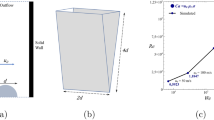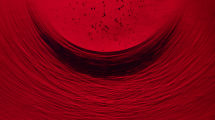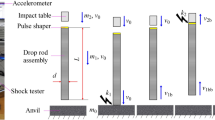Abstract
IN a study of impacting liquid sheets using high speed photography, we have observed the development of a wave pattern along the interface between the colliding liquids. The waves were similar to those reported in other studies on impact, notably in explosive welding of metal plates1, in ballistic impact2,3 and in the erosion of metal surfaces under the high speed impact of liquid drops4. Explanations concerning the wave patterns found in these investigations have been based on a study of the deformed and wavy surface after impact. Serious practical difficulties have usually prevented observation of the collision interface during the event. The technique to be described, however, has just this advantage, namely that waves can be observed to form during the impact. The fact that the collision occurs at low velocities between liquids need not seriously detract from the usefulness of the model. In the more extreme conditions of high velocity impact with solids, the impact pressure is sufficiently high compared with the flow stress of the solid that the problem is treated hydrodynamically anyway.
This is a preview of subscription content, access via your institution
Access options
Subscribe to this journal
Receive 51 print issues and online access
$199.00 per year
only $3.90 per issue
Buy this article
- Purchase on Springer Link
- Instant access to full article PDF
Prices may be subject to local taxes which are calculated during checkout
Similar content being viewed by others
References
Bahrani, A. S., Black, J. J., and Crossland, B., Proc. Roy. Soc., A, 296, 123 (1967).
Allen, W. A., Mapes, J. M., and Wilson, W. G., J. App. Phys., 25, 675 (1954).
Abrahamson, G. R., J. App. Mech., 23 (E), 519 (1961).
Bowden, F. P., and Brunton, J. H., Proc. Roy. Soc., A, 263, 433 (1961).
Phil. Trans. Eoy. Soc., A, 260, 73.
Birkhoff, G., MacDougall, D. P., Pugh, E. M., and Taylor, G. I., J. App. Phys., 19, 563 (1948).
Walsh, J. M., Shreffler, R. G., and Willis, F. H., J. App. Phys., 24, 349 (1953).
Cowan, G. R., and Holtzman, A. H., J. App. Phys., 34, 928 (1963).
Heymann, F. J., J. App. Phys., 40, 5113 (1969).
Hunt, J. M., Phil. Mag., 17, 669 (1968).
Author information
Authors and Affiliations
Rights and permissions
About this article
Cite this article
WILSON, M., BRUNTON, J. Wave Formation between Impacting Liquids in Explosive Welding and Erosion. Nature 226, 538–541 (1970). https://doi.org/10.1038/226538b0
Received:
Revised:
Issue Date:
DOI: https://doi.org/10.1038/226538b0
This article is cited by
-
Hazardous effects and microstructure of explosive welding under vacuum environment
The International Journal of Advanced Manufacturing Technology (2024)
-
Study on the Interface of Molybdenum Foil-copper Explosive-welded Composite Plate
Transactions of the Indian Institute of Metals (2023)
-
Linear analysis of Atwood number effects on shear instability in the elastic–plastic solids
Scientific Reports (2021)
-
Deformation and fracture of rocks due to high-speed liquid impingement
International Journal of Fracture (2004)
Comments
By submitting a comment you agree to abide by our Terms and Community Guidelines. If you find something abusive or that does not comply with our terms or guidelines please flag it as inappropriate.



